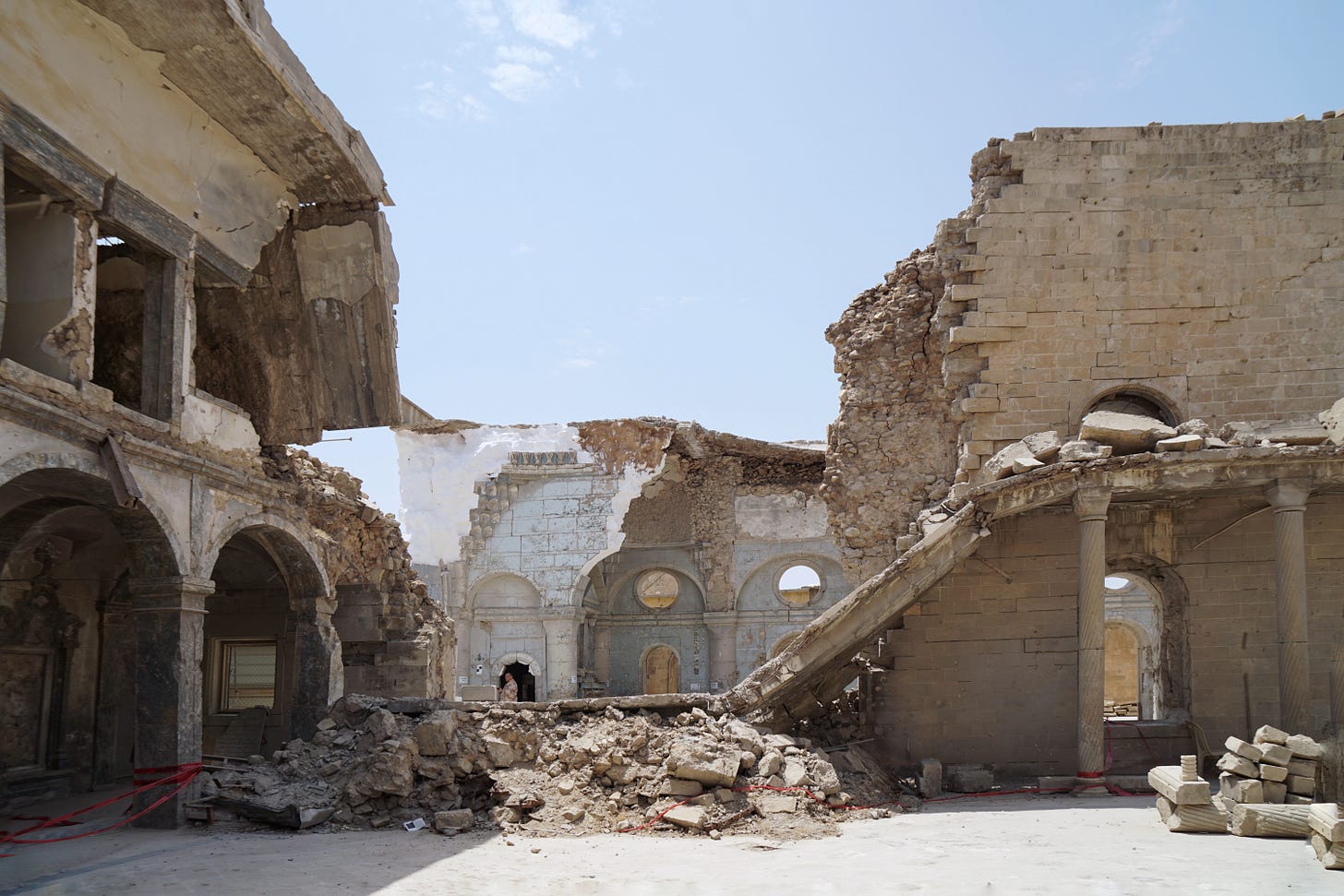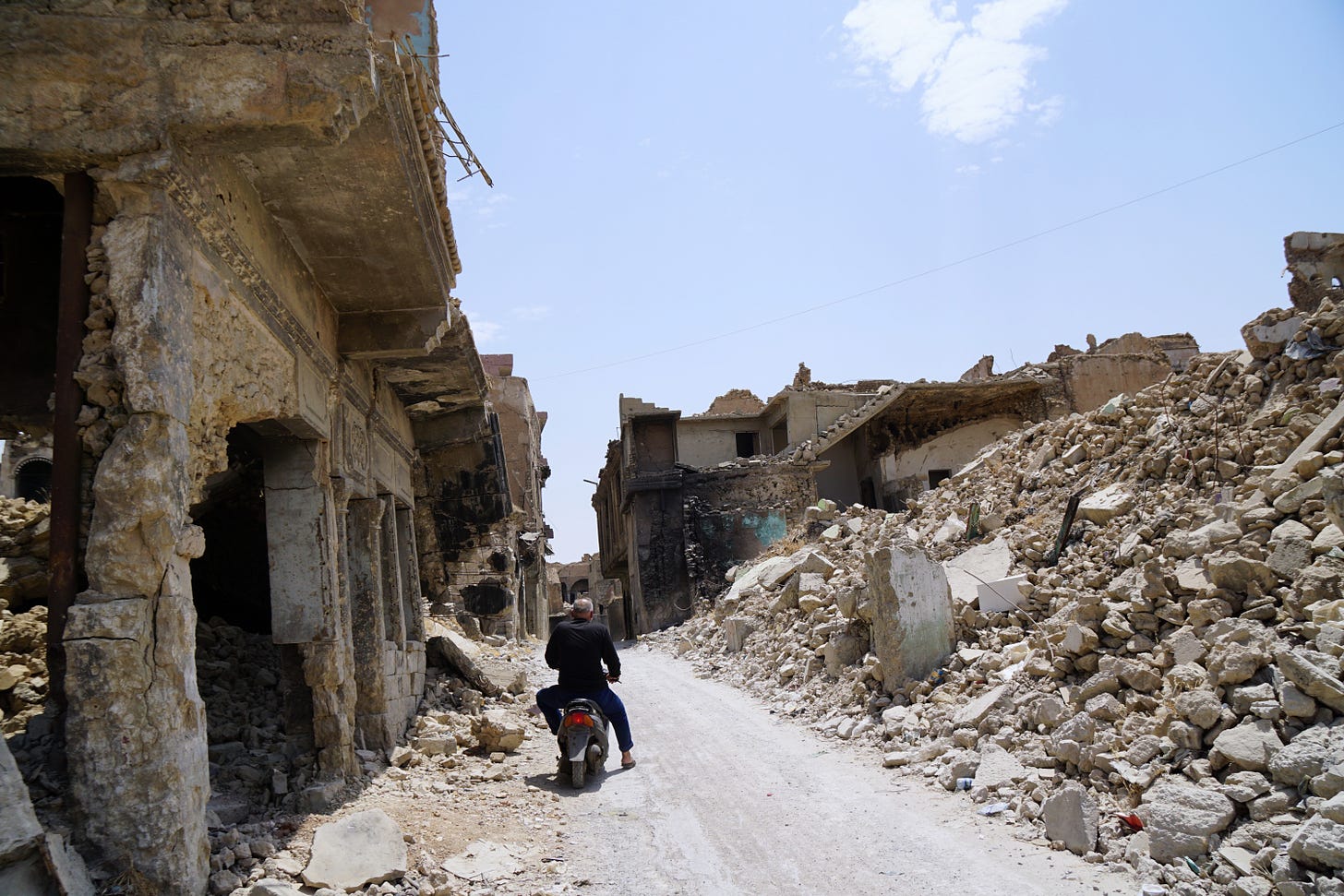How does Gaza compare with Mosul? / What's the new US military policy on civilian casualties?
Hello all,
I was on the Pat Kenny show yesterday and I was told that an IDF spokesperson who had been on the show earlier had compared the Israeli military operation on Gaza to the mission lead by an international coalition to liberate Mosul from ISIS that lasted from 2016 - 2017.
Mosul in 2021
In the radio interview I touched on a few points of difference but I thought it was worth outlining below why they’re different as I’ve heard the comparison used a few times.
You can read my dispatch for The Irish Times from Mosul in 2021 and the devastation still seen around the city years after the battle here.
You can also read my latest piece from the West Bank on the military raids on Jenin here.
Jenin after a military raid
Hannah
A few points re Mosul v Gaza (which is obviously a topic worthy of many PHDs and not just some bullet points)
ISIS v Hamas - ISIS fighters were mostly drawn from Iraq and Syria, but the extremist jihadi organisation with ambitions to establish an Islamic caliphate also attracted thousands of recruits from Europe, Asia, the Middle East, North Africa and the former Soviet states like Uzbekistan. These foreign fighters often did not speak Arabic and were often disliked and seen as outsiders by local communities. Hamas in contrast is an exclusively Palestinian organisation with deep roots in its local communities where it has had decades to built its military defences and network of tunnels.
As Josef Federman writes in this piece for the AP, Hamas’s “ideology, albeit violent, is focused on liberating what it says is occupied land through the destruction of Israel.” Hamas is not focused on establishing an Islamic Caliphate across multiple countries and has much clearer ambitions than ISIS which are harder to extinguish by military means.
Civilian casualties in Mosul v Gaza - The battle for Mosul laster from October 2016 until July 2017 during which time an estimated 9,000 civilians were likely killed in Mosul by all parties. In comparison, based on Israeli estimates of the number of Hamas fighters that have been killed which is higher than the US estimate, at least 20,00 civilians have been killed by Israeli forces so far in Gaza. That figure is widely viewed as an underestimate given the high numbers missing or under rubble and the difficulties in accurately accounting for people in the chaotic war time conditions in Gaza.
Worth a read:
FT - Military briefing: Battle for Mosul points to IDF’s ‘fiendish’ task in Gaza
Washington Post - Israel has waged one of this century’s most destructive wars in Gaza
Markaz - Gaza vs. Mosul from a Medical and Humanitarian Standpoint
Civilian abilities to seek safety - Many Iraqi civilians in Mosul were screened by Iraqi forces at filtration camps and allowed to find safety elsewhere in Iraq. Although some civilians were kept hostage by ISIS and prevented from fleeing at gunpoint - Hamas has also taken Israelis hostages for leverage over Israel.
Palestinians in Gaza were ordered to move to southern Gaza, which is controlled by Hamas, and are now unable to flee elsewhere to Egypt or Israel. Due to the historical precedent of the Nakba when hundreds of thousands of Palestinian fled what is now Israel in 1948 and have been since denied return, there are real concerns over whether if Palestinians took safety in Egypt for the duration of the military operation in Rafah that they would ever be allowed to return to Gaza.
It’s worth noting that a significant portion of Gazans have relatives in Israel. Many Arab Israeli families (who mostly identify as Palestinian) living in places like Tel Aviv, Haifa and Lod would likely welcome the opportunity to take in injured and orphaned child relatives from Gaza but that is simply not an option due to the Israeli redline on any return of Palestinian refugees to Israel. Meanwhile Netanyahu’s government is actively sought for Palestinians to be displaced to Egypt or other countries.
What are the crimes of deportation and forcible transfer?
“Forcing people, by expulsion or other coercive acts, to leave a place where they are living lawfully for reasons not allowed by international law could be a crime against humanity, a war crime or both.
When people are displaced across an international border, it is called deportation. When displacement occurs within a national boundary, it is called forcible transfer. Forced displacement does not require physical force and can be caused by threat or coercion.”
What is an appropriate number of civilians for a military to kill?
As Josep Borrell asked in a press briefing earlier this week, “How many is too many? What is the standard?"
I already shared an investigation by 972 into the lethal relaxing of Israel’s rules of engagement in Gaza.
It’s worth noting that the US Department of Defence published new 52-page guidelines at the end of last year on how to better protect civilians during military operations, while simultaneously continuing to support military aid to Israel that clearly is not carrying its military operations with similar safeguards.
As the NY Times reports, “Widely seen as the first of its kind issued by a modern military, the directive also calls for more standardized assessments of deadly incidents, allows for reopening past assessments and provides options for condolence payments, medical care and property repairs even “after time has passed.
While Advocates of civilian protections welcomed the changes.
“It finally opens the door in writing, clearly,” said Joanna Naples-Mitchell, a human rights attorney representing 21 families whose loved ones were killed in U.S.-led coalition airstrikes in Mosul, Iraq, between 2015 and 2017. The military acknowledged years ago that the cases were “credible,” but the victims have been waiting for a response to requests for condolence payments, often while managing serious injuries and disabilities.”
The old city of Mosul lies in ruins still to this day.
You can read Pentagon Press Secretary Air Force Maj. Gen. Pat Ryder statement on the guidelines here.
The department has long recognized that causing civilian casualties produces a moral dilemma for service members and the protection of civilian populations just makes strategic sense.
When then-Army Gen. Stan McCrystal took command in Afghanistan in 2009, he looked at the situation in the country and concluded that protection of civilian populations in the country was a paramount objective. "We will not win based on the number of Taliban killed, but instead on our ability to separate insurgents from the center of gravity — the people," he wrote at the time. "That means we must respect and protect the population from coercion and violence — and operate in a manner which will win their support."
Secretary of Defense Lloyd J. Austin III recognized this priority and in January 2022 he directed the Undersecretary of Defense for Policy Colin Kahl to develop a Civilian Harm Mitigation and Response Action Plan to outline steps the department will take, and the resources needed to put the recommendations in place. From this effort would come the DOD instruction, officials said.
The new instruction formally establishes DOD's enduring policies, responsibilities and procedures regarding preventing and mitigating civilian harm. The U.S. military has long had these concerns, but this places them all under one instruction and re-emphasizes the importance of the concept.
The instruction establishes U.S. policy on pre- and post-strike measures to address civilian casualties in U.S. operations involving the use of force, officials said. It also directs the appointment of a senior DOD civilian official "to develop, coordinate and oversee compliance."
The instruction demonstrates the importance DOD places on protecting civilian populations and the department's commitment to the responsible use of military force, officials said.
Moreover, the instruction also spells out that the department understands that better strategic outcomes are achieved by improving civilian harm mitigation and response.”




